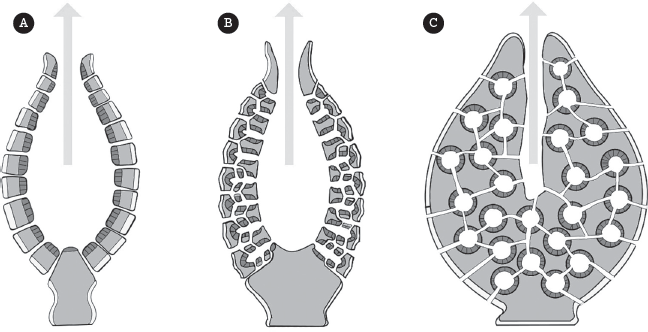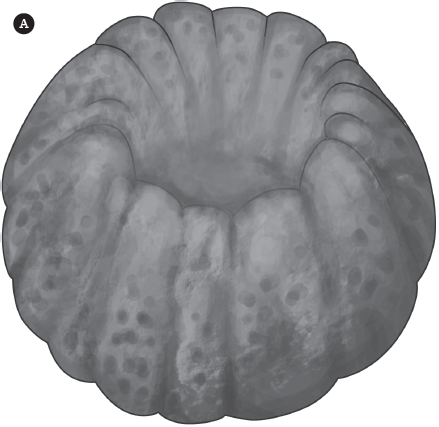Most people hear the word “sponge” and think of a block of synthetic foam, or of the cartoon character SpongeBob SquarePants. But sponges are actually the simplest and most primitive multicellular animals on the planet (fig. 11.1). Their fossil record goes back to the earliest Cambrian, and molecular data suggest that they originated even earlier but left no hard parts for many millions of years.
Figure 11.1 ▲
A reef in the Cayman Islands that hosts a variety of living sponges, including the yellow tube sponge Aplysina fistularis, the purple vase sponge Niphates digitalis, the red encrusting sponge Spiratrella coccinea, and the gray rope sponge Callyspongia. (Courtesy of U.S. National Oceanic and Atmospheric Administration)
Sponges are just one step above single-celled organisms. Each sponge cell is completely independent of the others and performs all of its own biological functions such as feeding, breathing, excreting waste, and reproduction. They have no specialized tissues or organs, as all other animals do. They are loosely connected to each other on a structure (or skeleton) made of tiny, woven, needle-like pieces known as spicules, which the individual cells collaborate to secrete as a support. They are so independent that if you force a sponge through a fine sieve it will reassemble itself into a new sponge. I doubt you could do the same if you were forced through a sieve!
The basic sponge structure is a tube-like or conical structure, shaped roughly like a chimney. The simplest sponges have only a single thin wall (fig. 11.2A) made of interwoven spicules, punctured by many small holes or pores throughout its surface. This is where the phylum gets its name, Porifera or “pore bearing” in Latin. Individual sponge cells line the wall of the tube and especially the canals that connect the outer pores with the inner pores into the central cavity. These cells have a whip-like flagellum that drives currents past them, allowing them to trap tiny food particles and oxygen and release their waste products.
Figure 11.2 ▲
The basic structure of the three types of sponges. (A) The simplest is the ascon type, which is a simple, thin-walled cylinder that pulls in water from the sides through the pores and then out through the top (see arrow). The sponge cells (dark areas) line the inner surfaces of the sponge and capture their food and oxygen in those currents. (B) The sycon sponge is also built as a simple cylinder, but it has much thicker walls penetrated by canals lined with sponge cells (dark areas). (C) The most complex is the leucon sponge, which has much thicker porous walls and only a small spongocoel in the middle. (Illustration by Mary Persis Williams)
All the currents flow from the outside to the spongocoel cavity into the middle of the sponge and then out the top of the chimney (fig. 11.2B), known as the osculum (“little mouth” or “little kiss” in Latin). The one-way flow of water through the walls and out the top is propelled by the flagella. The flow is also enhanced by the fact that the top of the sponge has a weak suction that draws upward like a chimney. The water flowing over the top of the sponge must flow faster than the water around it, and this increased velocity means less pressure. The decreased pressure over the top of the sponge relative to the rest of the surrounding water forces the water through the pores and out the top. This is the “chimney effect.” The top of a chimney has negative pressure compared to its sides, which creates an airflow that goes up through the chimney.
Sponges are very efficient at passing water through their canals. The entire internal volume of a typical sponge is replaced with new water nearly every minute. A black loggerhead sponge about 50 centimeters in diameter and 30 centimeters tall may draw about 1,000 liters of water through its canals in a single day. Some sponges may flush the equivalent of 10,000 to 20,000 times their internal water volume in a single day. To see this action, Google the term “sponge currents” and find one of the many outstanding videos that show a diver releasing a harmless dye into the water just outside the wall of the sponge. Within a few seconds, a strong plume of dye-filled water pours out the top.
The simplest sponges are just thin-walled tubes or cones or long cylinders. But most sponges have much thicker walls made of many spongy, porous areas perforated by long sinuous canals (fig. 11.2C). These formed the bath sponges that were originally collected on the seafloor by divers before synthetic foam replaced them. Most fossil sponges have very simple structures, with a rough shape that can vary a lot if the sponge lived in different environments. Their spicules are also diagnostic, and individual tiny spicules are often found in deep sea sediment. Some make their spicules out of silica, and they are known as glass sponges (fig. 11.3). Others use the common mineral calcite, and they are known as calcareous sponges. The ones that were once used for bathing make their spicules out of the flexible organic material known as spongin, which allows their skeleton to compress and be squeezed without destroying it.
Figure 11.3 ▲
Venus’s flower basket sponge, Euplectella. With the soft tissue gone, the delicate interwoven basket of glassy spicules can be clearly seen. (Courtesy of Wikimedia Commons)
Sponge fossils may not be nearly as spectacular as trilobites or dinosaurs, but during certain places and times they were extremely important to the ecology of the seafloor. Many organisms, including various worms, arthropods, fish, molluscs, and protozoans seek shelter in sponges because of their large, hollow, protective spongocoel. Some sponge predators may eat sponges to get at the sheltered animals inside. A single black loggerhead sponge was reported to contain over 10,000 organisms within its canals and skeleton. In some regions, sponge fishermen find so many hard-shelled molluscs in the sponges that their catches are worthless as bath sponges. The delicate, glassy, Venus’s flower basket sponge Euplectella is prized in the Orient as a wedding present (fig. 11.3). When shrimp move in and molt enough times, they become trapped because they are too large to escape through the grill over the osculum. Apparently, the pair of shrimp trapped in the glassy cage is symbolic of marriage in some cultures.
During the Paleozoic, sponges were the major reef builders in a number of instances, and they contributed to reefs built with corals as well. The first large colonial reef-building organisms on Earth were a group known as the Archaeocyatha (fig. 11.4). They formed huge reefs in the Early Cambrian in many parts of the world. They are organized in a structure similar to a sponge, with a cone-in-cone structure and an “I-beam” wall construction that separates the outer and inner walls. They were perforated by numerous pores, so they almost certainly fed and lived like sponges. However, paleontologists are still debating whether they were truly sponges or were only an early extinct experiment in the sponge-like body form. Archaeocyathans don’t have spicules like all other sponges, and there are many other fundamental structural differences as well. The debate may never be resolved because archaeocyathans vanished completely by the Middle Cambrian when undoubted sponges replaced them.
Figure 11.4 ▲
Sketch of a typical archaeocyathan, showing the porous conical outer wall with the double-walled internal structure, surrounding a central cavity. (Illustration by Mary Persis Williams)
Figure 11.5 ▲
Astraeospongia, the “star sponge”: (A) the overall shape is like a thick-walled bowl or dish; (B) close-up of the surface, showing the interwoven star-shaped spicules. ([A] Illustration by Mary Persis Williams; [B] courtesy of Wikimedia Commons)
Figure 11.6 ▲
Astylospongia, a common Silurian sponge about the size of a golf ball: (A) drawing showing their overall shape; (B) photograph of a well-preserved example. (Courtesy of Wikimedia Commons)
Other sponges are easy to recognize and can often be good index fossils. A typical Silurian sponge is Astraeospongia (star sponge), so named because specimens have star-shaped spicules (fig. 11.5A–B). This sponge forms a flat, concave, dish-like body, with the spicules etched out during weathering. Another common Silurian sponge is Astylospongia, which has thick walls and narrow canals and is about the same size and shape as a golf ball (fig. 11.6A–B). During the Silurian and Devonian, huge reefs were built in the tropics consisting of corals plus a sponge group known as the stromatoporoids (strohm-a-TOP-or-roids). These have a distinctive laminated structure in cross section (fig. 11.7A), with little bumps called mamelons, on the top surface (fig. 11.7B). Then there was a mass extinction in the Late Devonian, and stromatoporoid reefs vanished. They were replaced by reefs built by the glass sponge Hydnoceras, which were extremely common in the postextinction world of the latest Devonian (fig. 11.8A–B).
Figure 11.7 ▲
The layered sponges called stromatoporoids were the major reef-builders in the Silurian and Devonian, but they were wiped out during the Devonian mass extinction. (A) Their layered structure is very distinctive, as are (B) the tiny bumps (mamelons) on the top surface of each layer. (Courtesy of Wikimedia Commons)
Figure 11.8 ▲
The Devonian glass sponge Hydnoceras: (A) an individual sponge; (B) a colony of glass sponges from the latest Devonian. Cold-tolerant glass sponges replaced the coral-stromatoporoid reefs that had dominated the warm waters of the tropics in the Silurian and most of the Devonian. (Courtesy of Wikimedia Commons)











